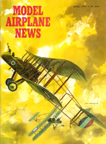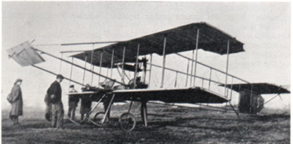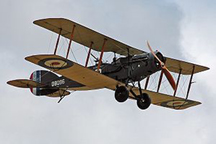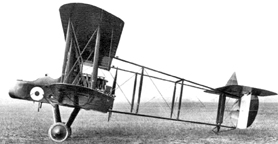March, 1964

RAF F.E. 2b and F.E. 2d
Model Airplane News Cover Art for March, 1964
by Jo Kotula
Click to Enlarge
The Royal Aircraft Factory F.E.2 was a two-seat pusher biplane that was operated as a day and night bomber and as a fighter aircraft by the Royal Flying Corps during the First World War. Along with the single-seat D.H.2 pusher biplane and the Nieuport 11, the F.E.2 was instrumental in ending the Fokker Scourge that had seen the German Air Service establish a measure of air superiority on the Western Front from the late summer of 1915 to the following spring.
The F.E.2 (F.E. ="Farman Experimental") designation actually refers to three distinct designs - although all were pushers based on the general layout employed by the French aircraft designers, the Farman Brothers. The first F.E.2 was developed by the Royal Aircraft Factory in 1911 by "rebuilding" the F.E.1 - a "boxkite" style biplane designed and built by Geoffrey de Havilland before he joined the Factory's staff. A further design with the "F.E.2" designation came out in 1913, but was destroyed in a fatal crash when the pilot, R. Kemp, lost control while in a dive. These designs are properly included in the F.E.1. Series.


Progenitor and Successor (L) F.E.-1 (R) Bristol FB2


RAF F.E. 2b and F.E. 2d
The gunner was in a precarious position...
Click to Enlarge
The F.E.2a that appeared in February 1914 was yet another totally new design, specifically intended as a "fighter". The first production order was placed in August. By this stage, the "pusher" design was becoming obsolete as far as aerodynamic performance was concerned, however, the RFC had not yet solved the problem of firing a machine gun through the propeller of a tractor aircraft (which the Germans were shortly to manage using Anthony Fokker's interrupter gear) and consequently, pushers, with a clear forward field of fire, remained the favoured configuration for fighters. The F.E.2 was a two-seater with the observer sitting in the nose of the nacelle and the pilot sitting above and behind. The arrangement was described by Frederick Libby, first American ace of World War I as follows:
"...When you stood up to shoot, all of you from the knees up was exposed to the elements. There was no belt to hold you. Only your grip on the gun and the sides of the nacelle stood between you and eternity. Toward the front of the nacelle was a hollow steel rod with a swivel mount to which the gun was anchored. This gun covered a huge field of fire forward. Between the observer and the pilot a second gun was mounted, for firing over the F.E.2d's upper wing to protect the aircraft from rear attack ... Adjusting and shooting this gun required that you stand right up out of the nacelle with your feet on the nacelle coaming. You had nothing to worry about except being blown out of the aircraft by the blast of air or tossed out bodily if the pilot made a wrong move. There were no parachutes and no belts. No wonder they needed observers..."
The F.E.2c was an experimental night fighter and bomber variant of the F.E.2b, the main change being the switching of the pilot and observer positions so that the pilot had the best view for night landings. Two were built in 1916, with the designation being re-used in 1918 for a similar night bomber version of the F.E.2b, which was used by 100 Squadron. In the end, the "observer-first" layout was retained for the standard aircraft. A total of 1,939 F.E.2b/cs were built.
The final model was the F.E.2d (386 built) had a bigger engine that improved speed, height and payload, so that in addition to the two observer's guns, an additional one or two Lewis guns could be mounted to fire forward, operated by the pilot. The F.E.2d was eventually replaced by the Bristol Fighter, the older F.E.2b proved an unexpected success as a light tactical night bomber, and remained a standard type in this role for the rest of the war. Its climb rate and ceiling were too poor for it to make a satisfactory night fighter.
Here is a video of the RAF F.E. 2b in action:
Click Here for more information about the RAF F.E. 2b and F.E. 2d.

Click to go back and select another cover.
Counter for the Entire Site (not just this page..)
Home | About Lindy | Last Week's Reviews | Upcoming Events | 1940s Collecibles
The Guide - Establishments - Travel - Accessories
Music | Links | Photo Gallery | Extras | Contact